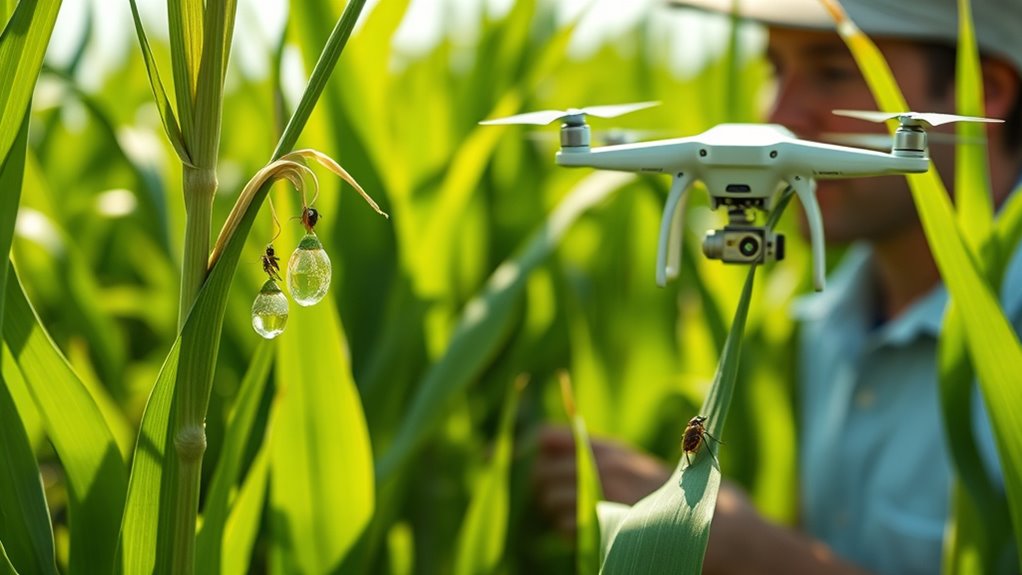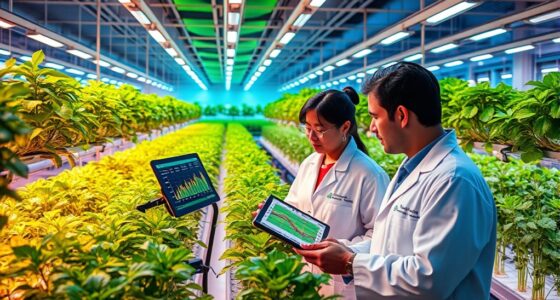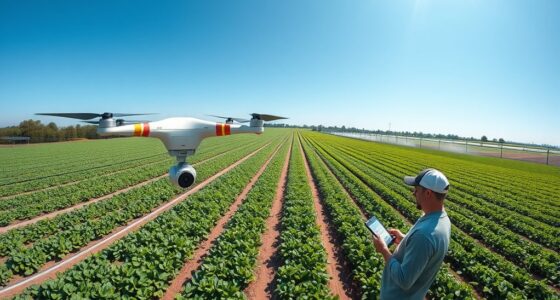Emerging pest-management strategies in major crops focus on using biological control methods like natural predators and microbial agents, reducing reliance on chemicals. Breeding resistant varieties through genetic techniques and gene editing also plays a key role. Integrated approaches combine cultural practices, crop diversification, and advanced technologies such as remote sensing, drones, and AI for real-time pest monitoring. These methods promote sustainable farming and environmental health—if you explore further, you’ll discover more about innovative tools transforming pest management today.
Key Takeaways
- Integration of biological, cultural, and chemical methods within IPM frameworks enhances pest control efficiency.
- Advances in genetic engineering and molecular techniques develop pest-resistant crop varieties.
- Precision agriculture tools like remote sensing and AI enable real-time pest monitoring and targeted interventions.
- Use of semiochemicals and natural enemies disrupts pest behavior and supports biological control.
- Emphasis on sustainable practices reduces pesticide reliance and promotes ecological balance in pest management.
Biological Control Methods and Natural Predators
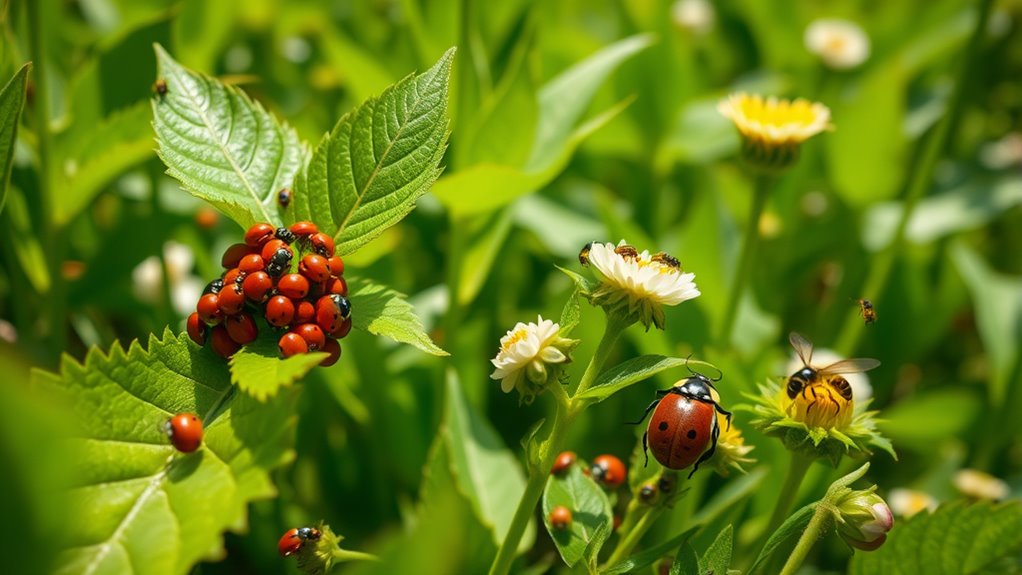
Biological control methods use natural predators, parasites, or pathogens to manage pest populations effectively. When you implement these strategies, you help maintain soil health, which is crucial for sustainable crop production. Healthy soil supports beneficial organisms that naturally suppress pests, reducing the need for chemical interventions. This integrated approach also benefits post-harvest storage by minimizing pest infestations that often occur during storage, since natural predators can keep pest levels in check before harvest. By fostering a balanced ecosystem, you create an environment where pests are naturally controlled, leading to healthier crops and improved storage quality. Incorporating biological control not only reduces chemical use but also promotes long-term pest management, ensuring your crops stay healthy from planting through post-harvest handling. Utilizing vetted biological agents ensures effective and environmentally friendly pest suppression. Additionally, understanding the ecological balance in your fields enhances the success of biological control strategies. Recognizing the importance of soil health can further improve how biological control methods are integrated into pest management plans.
Genetic Resistance and Breeding for Pest Tolerance

You can improve pest resistance in crops through targeted breeding techniques and selecting for genetic markers associated with tolerance. These methods help identify and develop plant varieties better equipped to withstand pest attacks. By focusing on genetic traits, you’ll enhance pest management efforts sustainably and effectively. Incorporating genetic resistance strategies such as molecular markers can further accelerate the development of resilient crop varieties.
Breeding Techniques for Resistance
Breeding techniques for resistance have become an essential part of integrated pest management strategies, as they offer sustainable solutions to reduce crop damage. You can leverage genetic engineering to develop pest-resistant varieties more efficiently and precisely. Resistance monitoring helps you track the effectiveness of these traits and identify emerging pest threats early. To improve resistance, consider:
- Incorporating genes from wild relatives through hybridization
- Using genetic engineering to insert specific resistance genes
- Selecting for pest-tolerance traits in breeding programs
- Regularly monitoring pest populations for resistance development
These methods enable you to create resilient crops that require fewer chemical inputs, promoting sustainable farming practices. By combining traditional breeding with modern techniques, you can stay ahead of pests and safeguard your yields effectively. Additionally, implementing data-driven marketing strategies can help promote your pest-resistant crops more effectively in the marketplace.
Genetic Marker Selection
How can selecting specific genetic markers accelerate the development of pest-resistant crops? By targeting genes linked to pest tolerance, you can breed varieties that resist pests more effectively. This approach shortens development time and improves accuracy, ultimately enhancing soil health by reducing chemical use. Effective irrigation management supports these crops’ growth, ensuring pest resistance traits are expressed ideally. Consider this visual:
| Genetic Marker Selection | Pest Resistance Traits |
|---|---|
| DNA fingerprinting | Tolerance to pests |
| Marker-assisted breeding | Reduced pesticide need |
| Rapid screening | Improved crop resilience |
| Soil health benefits | Sustainable pest control |
| Efficient breeding cycle | Longer-lasting resistance |
This method streamlines pest management, promoting healthier crops and more sustainable farming practices. Additionally, understanding the contrast ratio of the selected varieties can further optimize visual monitoring of pests and crop health. Incorporating integrated pest management strategies can also enhance the effectiveness of genetic resistance by combining biological, cultural, and chemical controls for comprehensive protection. Exploring genetic diversity can further strengthen crop resilience against evolving pest populations.
Integrated Pest Management (IPM) Approaches
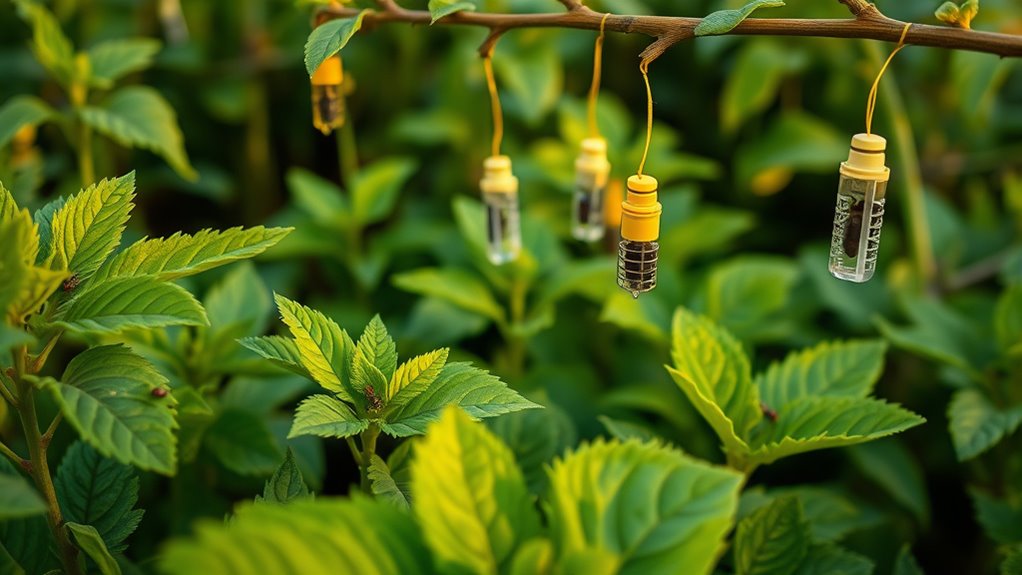
You can improve pest control by using Integrated Pest Management (IPM) approaches that combine different strategies. Biological control methods, like releasing beneficial insects, help reduce pest populations naturally. Additionally, cultural pest management practices, such as crop rotation and proper sanitation, play a vital role in preventing infestations. Incorporating pest-resistant crop varieties can further enhance the effectiveness of IPM programs. Utilizing secure payment processing solutions can also facilitate transactions for agricultural inputs and services efficiently. Recognizing the importance of regional expertise can assist farmers in selecting the most effective strategies tailored to their specific location.
Biological Control Methods
Have you ever considered how natural enemies can effectively manage pest populations? Biological control methods leverage predators, parasitoids, and pathogens to keep pests in check. To maximize their effectiveness, you should focus on disrupting pest habitat and maintaining crop sanitation. Proper crop sanitation removes plant debris and weeds that serve as pest refuges, while understanding pest habitat helps you introduce or conserve beneficial organisms. You might also:
- Release natural enemies at strategic times
- Use selective biopesticides to protect these allies
- Preserve biodiversity to support predator populations
- Monitor pest levels to ensure timely intervention
- Recognize the role of biodiversity in supporting predator populations
By understanding the ecology of pests and their natural enemies, farmers can develop more targeted and sustainable control strategies. These strategies work together to suppress pest populations sustainably, reducing reliance on chemical controls. By fostering a balanced ecosystem, you promote natural pest regulation and healthier crops.
Cultural Pest Management
Did you know that integrating multiple pest management tactics can considerably reduce reliance on chemical pesticides? Cultural pest management plays a key role by modifying farming practices to prevent pest problems. Techniques like crop rotation, adjusting planting dates, and proper field sanitation help disrupt pest life cycles. These practices also promote soil health, which enhances crop nutrition and resilience against pests. Healthy soils support vigorous plants that are less vulnerable to infestations. Additionally, selecting pest-resistant crop varieties and managing crop density can further deter pests naturally. By adopting these strategies, you create an environment less conducive to pests while improving overall crop productivity. soil health is a foundational element in sustainable pest management, as it underpins plant vigor and disease resistance. Signs of spoilage in stored produce provide insights into maintaining healthy crops and minimizing pest attractants. Cultural pest management emphasizes prevention, reducing the need for chemical interventions and fostering sustainable farming systems. Incorporating integrated pest management (IPM) approaches can further enhance pest control effectiveness by combining cultural, biological, and mechanical methods.
Use of Biopesticides and Microbial Agents
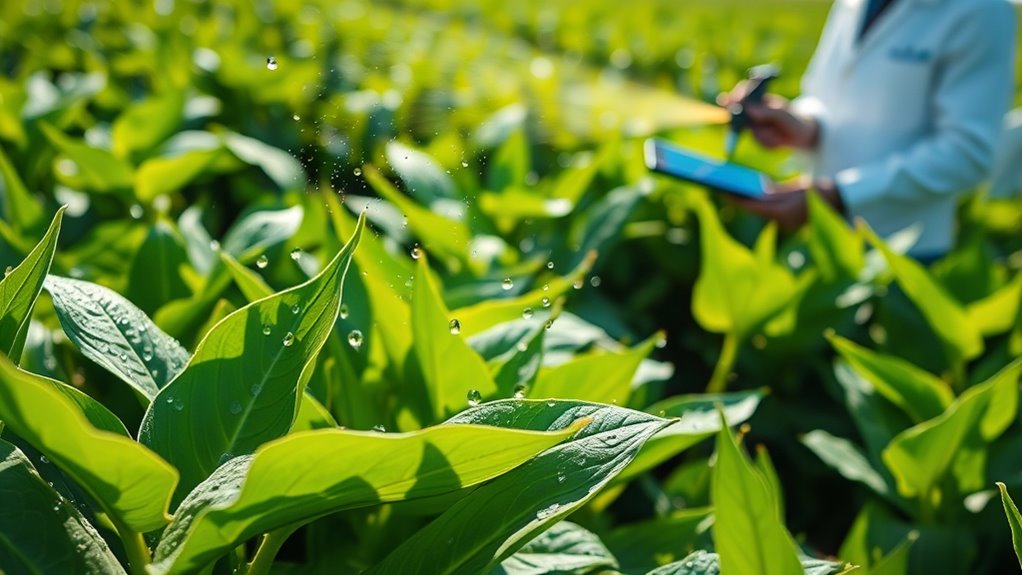
- Improve soil microbial diversity
- Enhance nutrient uptake
- Reduce chemical pesticide dependency
- Support sustainable crop production
Precision Agriculture Technologies for Pest Monitoring
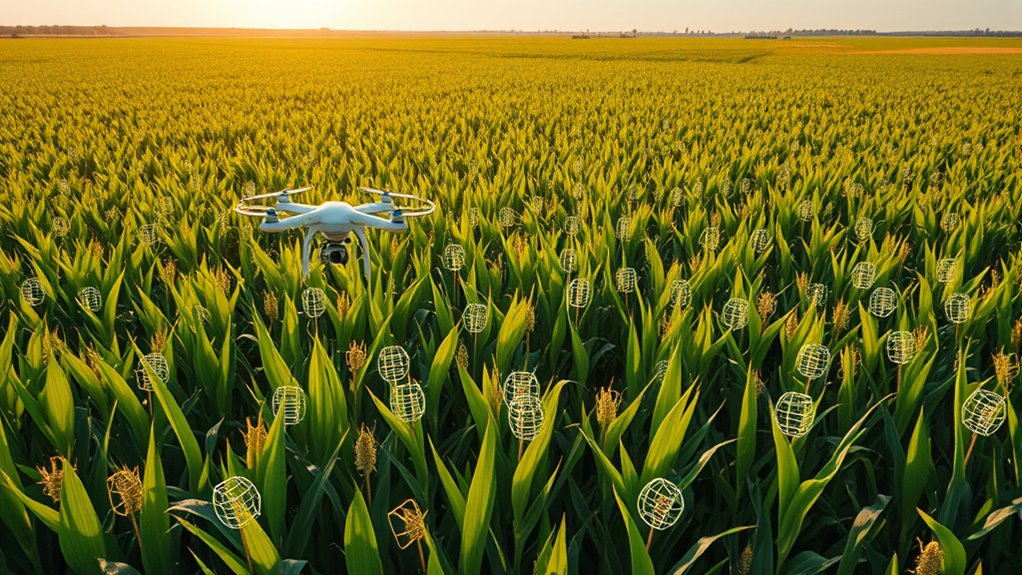
Advancements in precision agriculture technologies are transforming pest monitoring by enabling you to detect and respond to pest infestations more accurately and efficiently. Using remote sensing, drone imagery, and soil sensors, you can monitor soil health and identify early signs of pest activity. These tools help optimize irrigation efficiency, ensuring plants are neither over- nor under-watered, which can influence pest development. By integrating real-time data, you gain a detailed understanding of crop conditions, allowing targeted interventions that reduce pesticide use. Precision pest monitoring minimizes crop damage, boosts productivity, and promotes sustainable practices. Ultimately, these technologies help you make informed decisions, improve resource management, and maintain healthier soils, leading to more effective pest control and better crop yields.
RNA Interference (RNAi) for Targeted Pest Control
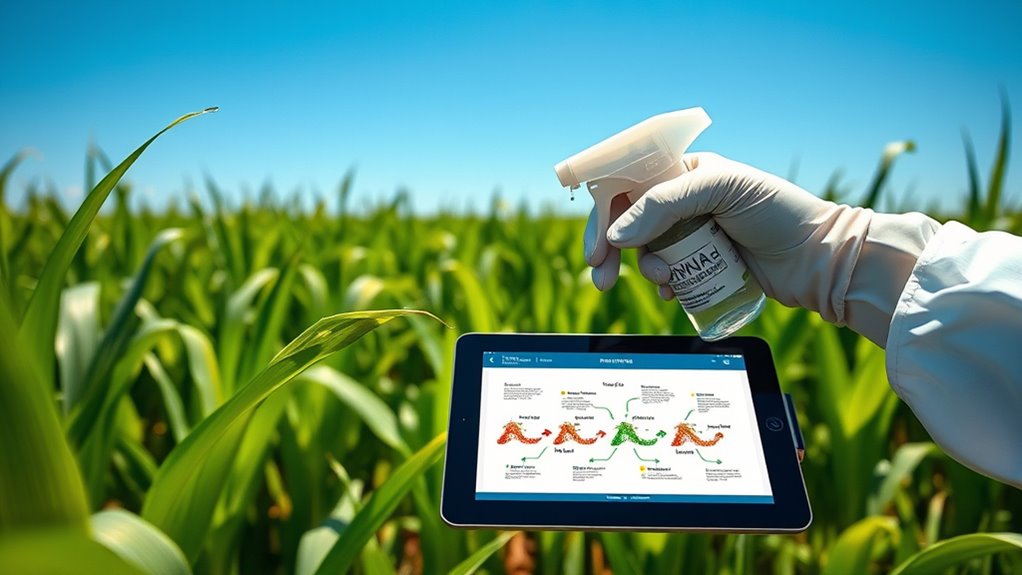
RNA interference (RNAi) offers a precise method for controlling pests by targeting specific genes essential for their survival or reproduction. By using RNAi delivery systems, you can induce gene silencing in pests, disrupting crucial biological processes. This approach minimizes effects on non-target organisms and reduces chemical use. To implement RNAi effectively, consider:
- Designing dsRNA molecules targeting pest-specific genes
- Optimizing delivery methods such as topical sprays or transgenic plants
- Ensuring stability of RNA molecules under field conditions
- Monitoring for potential resistance development
With gene silencing, you can achieve targeted pest suppression with high specificity. This strategy enhances integrated pest management, offering an environmentally friendly alternative to traditional pesticides. RNAi’s precision makes it a promising tool for sustainable crop protection.
Crop Rotation and Diversification Strategies
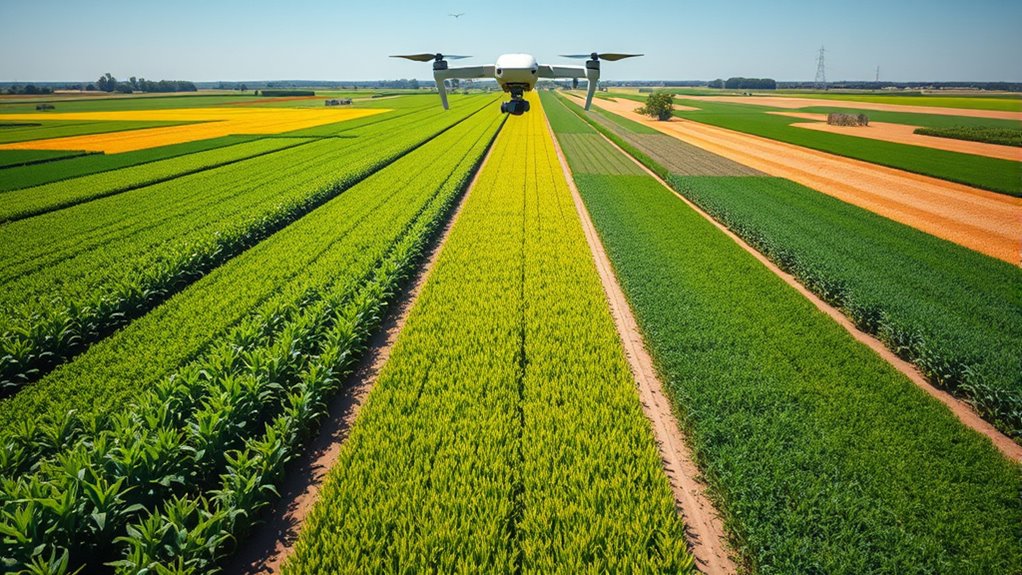
Crop rotation and diversification are essential strategies for sustainable pest management because they disrupt pest life cycles and reduce reliance on chemical controls. By varying crops, you promote crop diversity, which confuses pests and minimizes their populations. This approach also enhances soil health, as different plants contribute unique nutrients and reduce disease buildup. Incorporating diverse crops creates a resilient system that naturally suppresses pests and maintains productivity. Use the table below to see how different crop types benefit your system:
| Crop Type | Benefits |
|---|---|
| Legumes | Fix nitrogen, improve soil health |
| Cereals | Break pest cycles, diversify diet |
| Root Crops | Enhance soil structure, pest reduction |
Additionally, understanding pest management practices can further optimize your crop protection efforts.
Exploiting Plant Volatiles and Semiochemicals
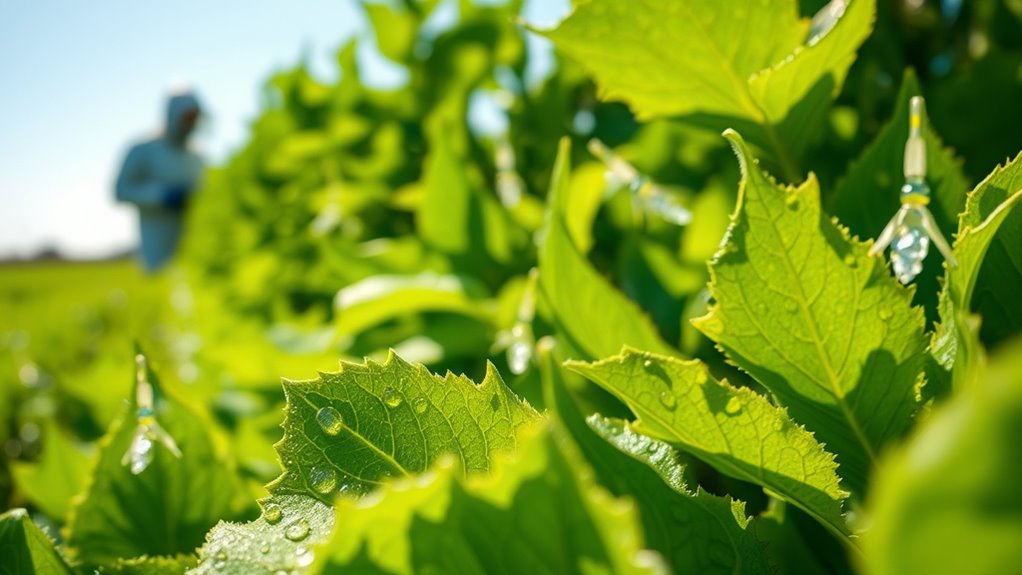
By using plant volatiles and semiochemicals, you can improve pest detection and monitor infestations more effectively. These chemicals can also manipulate pest behaviors, making them less likely to feed or reproduce on your crops. Implementing these strategies offers a targeted way to control pests with minimal environmental impact. Additionally, understanding chemical signaling in pest populations can enhance the development of more effective management tools.
Enhancing Pest Detection
Enhancing pest detection has become increasingly reliant on understanding how insects respond to plant volatile compounds and semiochemicals. By analyzing these signals, you can better identify pest habitat and early infestations, improving management strategies. Semiochemicals guide insects to specific crop areas, which often correlate with nutrient-rich zones. To optimize detection, consider:
- Using traps baited with plant volatiles that attract targeted pests
- Monitoring volatile emissions for signs of stress or damage in crops
- Deploying sensor technologies that detect semiochemicals in real-time
- Mapping pest movement patterns based on volatile cues to identify hotspots
- Integrating knowledge of Volkswagen Tuning practices can inspire innovative methods for pest detection tools, such as customizing sensors to recognize specific semiochemical signatures. Additionally, understanding the electric power generation capabilities of related devices can lead to developing autonomous sensor units powered sustainably for continuous monitoring. Incorporating sensor calibration techniques ensures the accuracy and reliability of semiochemical detection over time.
This approach allows you to pinpoint pest presence more accurately, reduce unnecessary pesticide use, and ensure timely intervention, especially in areas where pest habitat overlaps with nutrient-rich crop zones.
Behavioral Manipulation Techniques
Exploiting plant volatiles and semiochemicals offers a powerful way to manipulate insect behavior and improve pest management. Insects rely on behavioral cues, such as specific semiochemicals, to locate hosts or mates, making these signals ideal targets. By deploying synthetic attractants or repellents, you can disrupt pest adaptation, steering insects away from crops or luring them into traps. This approach minimizes chemical pesticide use and enhances selectivity. Understanding pest responses to these chemical cues allows you to develop more effective behavioral manipulation strategies. As pests evolve, exploiting natural signals becomes increasingly important to stay ahead of pest adaptation. Additionally, the integration of zodiac compatibility insights can inform the timing and deployment of these techniques, optimizing their effectiveness. Ultimately, this method provides a sustainable, targeted, and environmentally friendly tool to reduce pest populations and protect crop yields.
Remote Sensing and Data-Driven Pest Surveillance
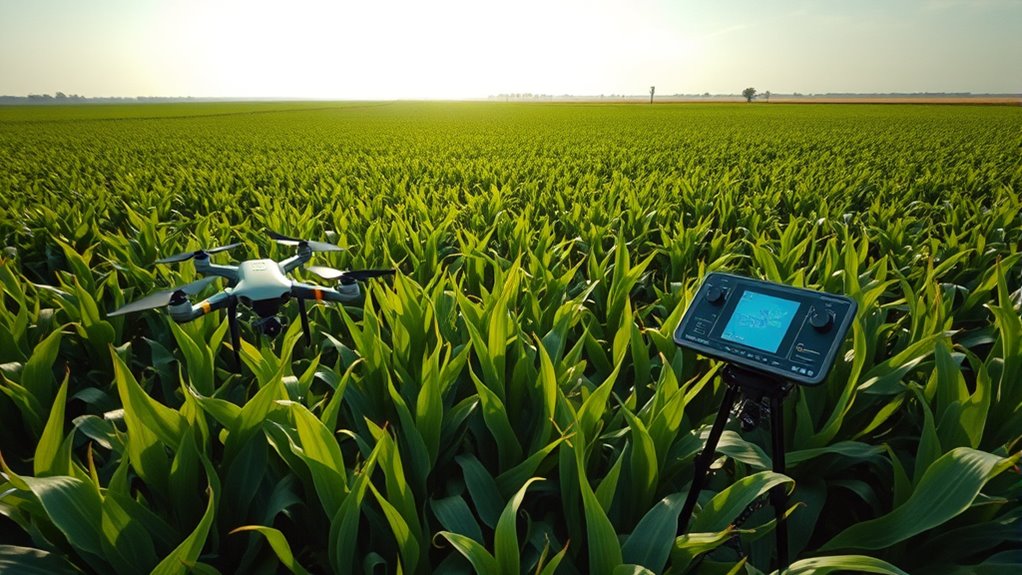
Remote sensing technologies have revolutionized pest surveillance by providing real-time, large-scale observations of crop fields. With these tools, you can detect urban pests and invasive species early, reducing crop damage. You’ll benefit from:
- Satellite imagery highlighting pest hotspots across vast areas
- Drone surveillance for detailed, high-resolution field scans
- AI algorithms analyzing data to identify pest outbreaks quickly
- Geographic Information Systems (GIS) mapping pest distribution patterns
These innovations enable you to target interventions efficiently, saving resources and minimizing pesticide use. You can also monitor pest migration from urban environments or invasive species spreading into new regions. By integrating remote sensing and data-driven insights, you stay ahead of pest threats, ensuring healthier crops and improved yield management. This proactive approach transforms pest surveillance into a precise, scalable process.
Adoption of Sustainable Farming Practices for Pest Reduction
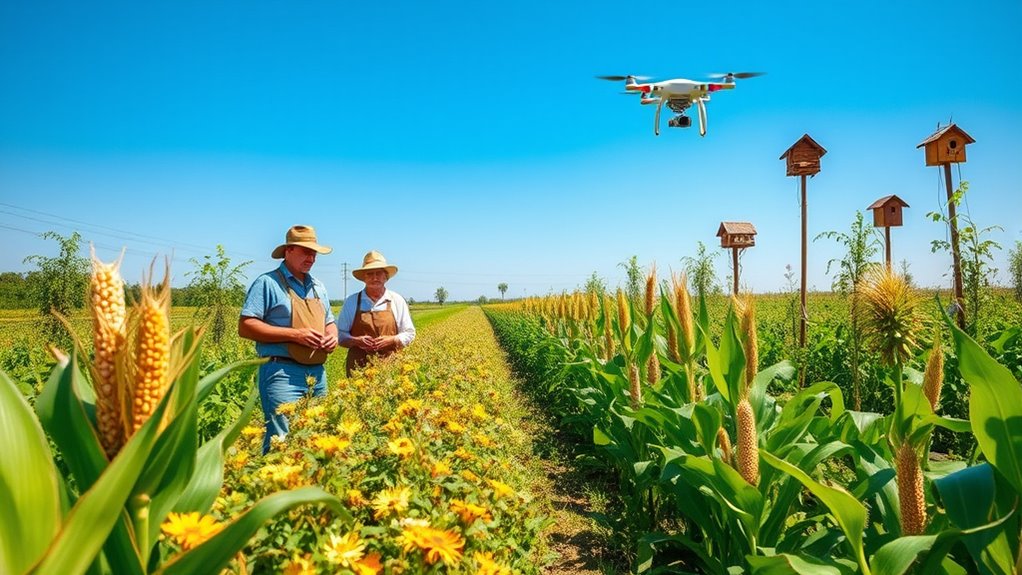
Adopting sustainable farming practices has become a crucial strategy for reducing pest populations naturally and minimizing reliance on chemical controls. By pursuing organic certification, you emphasize practices that avoid synthetic pesticides, promoting healthier ecosystems. Improving soil health through cover cropping, crop rotation, and organic amendments enhances plant resilience against pests. Healthy soils foster beneficial microorganisms that naturally suppress pest populations, reducing the need for chemical interventions. These practices not only cut down on pesticide use but also support long-term farm productivity and environmental sustainability. As you adopt more sustainable methods, you contribute to a balanced agro-ecosystem where pests are kept in check naturally. Embracing organic certification and prioritizing soil health are key steps toward effective, eco-friendly pest management.
Frequently Asked Questions
How Do Emerging Pest-Management Strategies Impact Crop Yields Long-Term?
Emerging pest-management strategies markedly impact your crop yields long-term by promoting crop diversity, which reduces pest resistance risks. When you incorporate diverse crops, pests find it harder to adapt and spread, leading to healthier fields. These strategies help break pest cycles, improve resilience, and sustain productivity. As a result, you can expect more stable yields over time, with fewer chemical interventions needed, supporting both environmental health and your farm’s profitability.
What Are the Economic Costs of Implementing New Pest-Control Technologies?
You might find that implementing new pest-control technologies costs farmers an average of 15-20% more initially, but a thorough cost benefit analysis often shows long-term savings through reduced pesticide use and higher yields. While technology affordability remains a concern, investing in these strategies can boost profitability over time. Ultimately, weighing the upfront expenses against potential gains helps you make informed decisions about adopting innovative pest-management solutions.
How Do Pest Management Strategies Vary Across Different Climate Zones?
You’ll find that pest management strategies differ across climate zones because they require climate-specific approaches tailored to regional pest dynamics. In warmer areas, you might focus on controlling pests that thrive in heat, while cooler zones need strategies for pests adapted to lower temperatures. Understanding regional pest dynamics helps you develop targeted, effective methods for each climate, ensuring you manage pests efficiently and minimize crop damage in diverse environments.
What Are the Potential Environmental Risks of Novel Pest-Control Methods?
Ever wonder about the environmental impact of new pest-control methods? These innovative strategies can reduce chemical use, but they also pose risks like ecosystem disruption and unintended harm to beneficial insects. Are we truly safeguarding the environment, or could we cause more damage? You must weigh the benefits against the potential for ecosystem imbalance, ensuring that pest management advances don’t come at the expense of ecological health.
How Do Farmers Adopt and Adapt to Innovative Pest-Management Practices?
You adopt and adapt to innovative pest-management practices by actively engaging in farmer training programs that teach new techniques and technologies. You stay informed about pest resistance issues and adjust your methods to maintain effectiveness. You experiment with integrated strategies, monitor pest populations, and share experiences with other farmers. This proactive approach helps you implement sustainable solutions, reduce reliance on chemicals, and improve crop health while responding to evolving pest challenges.
Conclusion
By adopting biological controls, embracing genetic resistance, implementing integrated pest management, utilizing biopesticides, leveraging precision agriculture, practicing crop rotation, exploiting plant semiochemicals, using remote sensing, and promoting sustainable practices, you can effectively reduce pests, enhance crop health, and guarantee environmental safety. These strategies work together to create a resilient, sustainable farming system that minimizes chemical reliance, maximizes productivity, and preserves natural ecosystems. Together, these emerging pest-management approaches empower you to farm smarter, safer, and more sustainably.
